|
|
 |
The three great religions of China are Confucianism (Rujiao 儒教), Daoism (Daojiao 道教) and Buddhism (Fojiao 佛教). In the course of history, many religions like Manicheism (Monijiao 摩尼教), Islam (Yisilanjiao 伊斯蘭教) and Christianity (Catholicism: Tianzhujiao 天主教, Protestantism: Jidujiao 基督教 or Yesujiao 耶穌教; Nestorianism: Jingjiao 景教) came to China but none of them was able to establish more than small parishes.
The veneration of Confucius (Kongzi 孔子) as the teacher of teachers started during the Han Dynasty 漢 when Confucianism became state doctrine. Confucian temples (Kongmiao 孔廟) are quite simple and unemotional compared to Daoist temples. Because Confucius laid stress on education by harmony and music, in most Confucian temples three types of music instruments are seen: drums (gu 鼓), bells (zhong 鐘) and sounding stones (qing 磬). All other music instruments are not of Chinese origin or does at least not come from the Yellow River basin, the center of Chinese culture.
Confucianism means also veneration of the ancestors. Every family in traditional China (and in modern Taiwanese, Hong Kong and oversees Chinese houses) possesses a small shrine in the main room of the house where the grand parents are venerated and given a food offering every day.
Veneration by incence sticks is also a central point of Daoist religion. Founded as a philosophy of self-cultivation far from the daily business, Daoism became a religion of helping heroes and wonderful mighty gods already during the Han Dynasty. It was highly intermingled with deities of popular religion and thus has many different objects of veneration in different regions, different social strata and different occupations. It can be compared to the belief in the many saints of Catholicism. Most popular gods of the Daoist religion are the deified philosopher Laozi 老子, called Laojun 老君 "The Old Lord", the Eight Immortals (Baxian 八仙), the God of the Yellow River (Heshen 河神), the God of Money (Caishen 財神), or the historical hero Guan Yu 關羽, called Guan Gong 關公 "Duke Guan". The colorful thought of Daoism is also expressed in Daoist temples (daoguan 道觀) whose roofs and tiles are covered with dragons, lions and small figurines of groups of immortals. Symbols that are also connected with Daoism are the black-white Yin-Yang 陰陽 disk and the Eight Hexagrams (bagua 八卦). A great part of Daoist belief is not exerted at temples but outside the doors. Technics that serve to promote health and to prolong one's lifetime are the very popular Taijiquan 太極拳 ("T'ai-chi") and Qigong 氣功 and medicine practices like acupuncture and moxibustion. According to a legend, Laozi left China, riding a water buffalo and going to the west.
A religion that came back to China from the west was Buddhism. In the first centuries, many common points among Buddhism and Daoism made the first only look like a special sect of Daoism. Indeed, meditating practices and the withdraw from worldly affairs made the two religions very similar. The practice of the Falungong 法輪功 sect during the last years make it very clear that in thought, both religions have many similar points: "fa lun" means "wheel of the law", or, in Buddhist terms "dharmacakra".
Buddhism came to China from Central Asia. It was the branch of the Great Vehicle (dasheng 大乘) that makes it possible for everybody to gain access to Nirvana by simple praying to the Saints of Buddhism, the Bodhisattvas (Pusa 菩薩). The most important of them are the Puxian Pusa 普賢菩薩 and the feminine Guanyin Pusa 觀音菩薩 (sometimes having a thousand benevolent arms). A special group of Bodhisattvas are the so-called Arhats (Luohan 羅漢), persons that are very near to popular belief and some of them having a very odd outlook. The prayer niches are mostly decorated with a main Buddha, two disciples and two Pusas. Heavenly guardians with fierceful faces protect this holy group from evil hell demons. The Buddhist monasteries are organized like the great Daoist monasteries with a bishop or an abbot, clearly separated between men and women. The most famous monasteries are the first Buddhist monastery, the "White Horse Monastery" Baimasi 白馬寺 near Luoyang, the Shaolin Monastery 少林寺 where the monks engaged in fighting arts, and the Buddhist island Putuoshan 普陀山 at the seashore of Zhejiang Province.
Christianity came to China during the late Ming Dynasty 明 and was able to attract a large portion of the ruling class. But the clash with Roman orthodoxy concerning ancestral ritus and the prohibition of the very successful Jesuit order ended the great age of Christianity in China.
Islam is widespread in China's western parts, but one can find moschees all over China. One of the oldest moschees in China is that of Quanzhou 泉州/Fujian. The difference between the moschee of main China and the Central Asian moschee is the missing of a minaret in China proper.
 |
< A very rare statue of Confucius from a
Confucius temple. In most cases, Confucius temples show
no statues at all. The Master is venerated as teacher,
before somebody will take a test. |
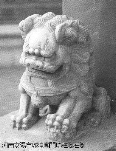 |
< Lions (shizi 獅子) are the usual
decorators of entrances to palaces and halls since the
Ming dynasty. It is a female and a male lion, the former
accompanied by its young, the male one playing with a
ball (Chenghuang Temple城隍廟, Anyang 安陽/Henan). |
 |
< Guardians at the Way of Soul (shendao
神道) that leads to the Qing period 清 Jiaqing 嘉慶 Emperor's tomb. The left
statue shows a civil official (wenguan 文官)
with the typical clothes of the Manchu government
officials, the black and red cap and a long necklace. The
right one is a war official (wuguan 武官),
wearing a kind of weapon and a big helmet, from a Ming emperor's tomb. |
 |
 |
< The Ways of Soul are also equiped with mythical
animals like the qilin 麒麟 on the left, a
mixture of lion and dragon, usually translated as unicorn.
It is from a way to the tomb of Emperor Chen Wendi 陳文帝. |
  |
< Two examples of eunuch statues. The
left one stands in Jinci Temple 晉祠 (Shengmu Hall 聖母殿) in Taiyuan 太原/Shanxi as courtier of a
large group of statues. The right one is the stele of a
praying eunuch from the Ming time, probably showing a
picture of a real person that offered this statue as a
votive offering. |
  |
< The statue of a servant maid to the left is from
the same temple as the left eunuch, both from Northern
Song 北宋. The statue to the right is a servant maid from the
grottoes at Maijishan 麥積山/Gansu also from the Song period. |
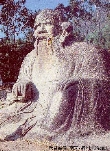 |
< A huge statue of Laozi 老子 at Quanzhou 泉州/Fujian
from the Southern Song 南宋 time. As a Daoist teacher, he
merges with nature, cut in a natural stone at its native
place, like being a part of nature. The original building around the statue has vanished. |
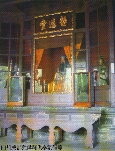 |
< In many temples, the venerated gods or deities
are enclosed in a glass shrine, like this example of
popular belief in deified historical persons: Liu Bei 劉備,
a ruler of the Three Kingdoms 三國 in Sichuan. |
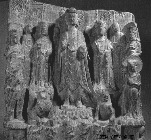 |
< This is an early relict of Buddhist
art in Sichuan during the Southern Dynasties 南朝. It shows
Buddha, standing of a lotus flower, surrounded by his
disciples. The stele was found in the relics of Wanfo Monastery 萬佛寺 near Chengdu 成都. |
  |
< A Northern Dynasties 北朝 long necked Buddha
standing solitary on a lotus flower. This stele was originally placed in the Xingguo Monastery 興國寺, Boxing 博興/Shandong. Also from the
Northern Dynasties stems the pillar to the right,
decorated with niches, that are used by monks and
Bodhisattvas for comtemplation. |
 |
< Luohans 羅漢 or Arhats, the caritative
beings that already have the key to salvation, but mere
want to help many people to find the way to Nirvana,
are very popular in China. In a Northern Song monastery
in Shandong (Lingyan Monastery 靈岩寺, Changqing 長清) sits this group of Luohans, each with a
different gesture and outlook. |
 |
< Heavenly kings are protectors of Bodhisattvas
and those faithful in Buddha's way of salvation. This
Yuan 元 time King (Duowen Tianwang 多問天王) holding a stupa
stands in the White Horse Monastery 白馬寺 near Luoyang. |
 |
< This half-naked statues of the Yuan
time still clearly show the influence of Indian art. The
climate of China would not in any case be like walking
around like the Bodhisattva to the left from Fusheng Monastery 福勝寺 in Xinjiang 新絳/Shanxi. |
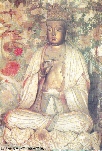 |
< A Bodhisattva sitting on a lotus flower in
contemplation, showing gestures of benevolence, in a Yuan
time monastery (Qingliansi 青蓮寺, Jincheng 晉城/Shanxi). |
 |
< Luohans sometimes have a very odd
outlook, like demons or gnomes. This red faced Luohan
named "Evoking the Dragons" (Xiang long Luohan
降龍羅漢; his name is Gashaba 嘎[(阝+少)/雅]巴) stands in the White Horse Monastery 白馬寺 at
Luoyang 洛陽/Henan. It was made at the end of Yuan Dynasty. |
 |
< A Bodhisattva riding an elephant, a quite rare
depicting outside of the Dunhuang grottoes. This Yuan
dynasty statue elephant near Hangzhou 杭州/Zhejiang stands upon lotus
flower, holding a flower with its trunk as a standing
base for the Bodhisattva. |
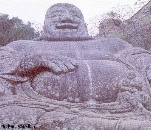 |
< A very popular Bodhisattva is the
thick belly Maitreya (Milefo 彌勒佛). Like the upper picture of Laozi, it
is cut out of a natural stone just at its original place
in Haikou 海口/Fujian during Yuan dynasty. |
 |
< Bodhisattvas praying to Buddha, statues of the
Liao Dynasty 遼 in Huayan Monastery 華嚴寺 in Taiyuan 太原/Shanxi. Both of the left statues wear a five part
crown, showing the five composition parts of sentient
being. |
 |
< A thousand arms Guanyin Bodhisattva (Qianshou Guanyin 千手觀音)
from the Ming Dynasty, Shuanglin Monastery 雙林寺 in Pingyao 平遙/Shandong. The thousand arms help the
feminine Bodhisattva to save the beings from suffering.
It is a typical pattern from Indian art, pictures of
Hinduist deites like Shiva also have many arms. |
  |
< Two disciples of Buddha, both having shaved
their hair. The left from the Five Dynasties 五代 (Zhenguo Monastery 鎮國寺, Pingyao 平遙/Shanxi), the right
from Ming time (Xiaoxitian小西天, Xixian 隰縣/Shanxi), they show a very different outfit, the
left meager and contemplated, the right disciple fat and
joking. |
|
|
|